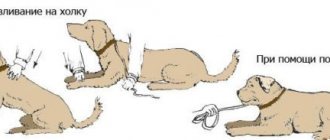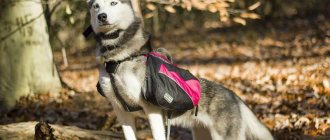Dog training is an important component of raising a pet, allowing the owner and his ward to understand each other, as well as to have fun and interesting time together. This kind of communication with a pet brings not only pleasure from spending time together, but also mutual benefits. Using different commands for dogs, the owner is able to accustom the pet to behavior that is safe for himself and others, improve his motor and vocal abilities, speed, reaction, ability to distinguish situations and react correctly to them.
- "Sit"
Sit
Take a treat in your hand and bring your fist to your pet's face so that he can smell the smell. Slowly raise your hand up so that the dog reaches for the treat, lifting its nose. At this moment, intuitively, dogs most often sit down.
Voice the command. If the dog sits on his own, give him a treat. If not, repeat the command and lightly press your hand on the sacrum. After several such repetitions, the animals understand what is wanted from them.
Second phase. Once the dog begins to sit, it becomes simply unbearable to receive the coveted treat.
The dog may sit for a second or two, and then explode and begin wagging its tail, jumping and demanding a treat. At this moment you can’t give him anything. You need to sit the dog down again, wait about five seconds, and only then praise him for the exercise.
When the dog stops jumping up before receiving the treat, move on to the third stage. Along with voicing the command, show it with a gesture (see figure). A command is considered to be learned when the dog begins to execute it at a distance of 2–3 m.
Graphics: Dmitry POLUKHIN
Necessary equipment
For independent training with your pet, you will definitely need a collar and leash for control and manipulation, a stick or toy for fetching, as well as a pre-prepared treat. These simple things may be enough to help your dog follow basic commands.
If you plan to prepare your dog for more serious exercises, such as obstacle racing, wall climbing, descent and ascent, you need to arrange the area in advance, prepare barriers and other devices. You should read the necessary literature in advance and choose the right equipment depending on the age, height and weight, breed and physical abilities of your dog. It is best to start this kind of training at a dog training school, and then continue at home, following the example.
Lie
If your pet has learned the “sit” command, consider that he has almost learned the “lie down” command. We give the command “sit”, wait for the four-legged dog to fulfill it, after which we show him a treat in his hand, which we gradually move to the side at floor level. At this moment, when the animal begins to reach for the treat, we give the command “lie down” and press a little on the dog’s withers, preventing it from jumping up on its paws. The dog will reach for the hand with the treat and stretch into the correct position.
The second stage is to learn this command using a gesture (see figure). Add the gesture to the voice command when the pet begins to lie down on its own, without your hand on the withers. Then gradually increase the distance from which the dog executes the command.
Graphics: Dmitry POLUKHIN
Easy to train breeds
All animals, like people, have their own individual character, so if you decide to train a dog at home, it is best to start with a breed whose representatives are distinguished by their flexible character and diligence.
The best ones to train are:
- The German Bear has a good-natured, calm character, but you need to start working with her from a very young age, otherwise she will grow up uncontrollable.
- The Italian Canne Corso - there will be no problems with him either - has excellent memory, but does not communicate well with other breeds.
- The Basset Hound is a cheerful hunter and quickly gets along with children. In addition, the animal is strong and resilient.
- Black Russian Terrier - only a strong, strong-willed person can work with him; the animal has a corresponding character. But if such a specialist is found, then the dog will carry out all his commands with ease.
- with the Maltese either; he learns easily and willingly, but due to his small stature and weak body, he gets tired quickly.
- The German Shepherd is a more loyal dog; it has a temperate, Nordic character, but at the same time it is an excellent nanny. He carries out commands easily, and most importantly, with pleasure, because the “German” loves to work.
Stand
It is better to learn this command when the dog learns to lie down when ordered. The lying position will be the starting position. The pet must be wearing a collar and on a leash. Lift your dog up by the leash until he stands on his paws. Voice the command and give a treat when the animal takes a stance. Treat him with a treat when the dog is standing upright, not trying to sit down on his butt.
Graphics: Dmitry POLUKHIN
The need for master training
Dog training carried out by owners usually pursues several goals. When starting a lesson, the owner must set himself a specific goal that he intends to achieve in the end. In general, any training for a four-legged friend is based on the following “pillars” of training:
- It promotes recognition of undeniable authority in the owner, which will help the puppy to better understand his status.
- The owner, by developing the desired reflexes in the pet, learns to anticipate its behavior in a specific situation. This allows him to adjust his communication tactics in time.
- All trained dogs are considered social creatures, able to get along with people and with their relatives.
During the learning process, motivational means are used, playing the role of a kind of gratitude for work. The maximum return from a four-legged animal is achieved if it is immediately rewarded following the action performed as ordered. Since training a dog correctly means not making excessive delays in actions, all attributes involved in training are prepared in advance.
Deterrent methods are objects that attract attention. What are things used for that produce a sharp sound - whistles, rattles made from tin cans with stones, a bunch of keys. If the pet does not follow the owner’s orders, it is excluded from deserved attention - praise, stroking. They send him to his place, pronouncing the order in a stern voice.
When punishing a puppy, it is better to use the ignoring method, which is recognized as more effective than punishing with physical force. Spanking is regarded by the dog as a play signal.
Since training a dog is considered a rather labor-intensive task, the owner can also motivate himself to the training process. It is important to realize that training a dog to behave properly is always easier than correcting behavioral deviations in the future.
To me
You'll need an assistant here. You need someone to hold your puppy or on a leash while you walk a short distance away from him.
Stop, pat your hand on your thigh and say, “Come to me.” At this moment, the dog should be released so that it runs towards you. If he doesn’t run, squat down, start calling and show him the treat in your hands. When the puppy approaches, give him a treat and pet him.
If the dog ignores your command several times, pause and do something else, put it on a leash or leave the stick. Otherwise, the animal will decide that it is okay to disobey you.
Place
Training consists of several stages. Training should begin when your little friend knows the commands “lie down” and “come to me.”
Choose a place, lay a rug, a blanket there, or place a special lounger, then place a toy or bone nearby and start training.
Step one. Bring the dog to his place and say: “Lie down.” After this, move a short distance and call your pet to you. When the dog follows the command, give reinforcement and praise.
Step two. Repeat the exercise, but now point towards the sunbed with your hand and say: “Place.” The puppy can be slightly pushed in this direction by repeating the command. If the dog settles down, say “Place” again. If he doesn’t want to, give the command “lie down”, wait for it to be completed and repeat the command “place”. Thank you with a tasty treat, then walk back a few steps and call your pet to you.
Step three. Leave a treat on the bedding or, better yet, hide it in a toy to make it more interesting for your dog to look for it. Voice the command “place”. When the dog comes up to eat the treat, say: “Lie down,” praise him for following the command, and while he lies on the mat for at least 5 seconds, repeat the “place” command and treat him with the treat again.
After a few days of training, increase the distance from which the dog approaches its place to several meters.
– Basic commands, such as “sit”, “lie down”, “stand”, can be taught by yourself, but complex ones, for example, “barrier”, “die”, “fetch”, “jump on the back” - only with a dog handler. In these teams, you need to carefully monitor the execution technique, and in some exercises you even need to catch the dog, warns dog handler Zlata Obidova. – The general training course lasts two months, after which, if the dog has learned everything, a certificate is issued. But everything is individual. For some animals, even 15–20 sessions may not be enough.
When signing up for courses, pay attention to what breeds of dogs are recruited into the group. Animals must be similar in size. Dwarf breeds cannot be trained together with fighting breeds.
When is the best time to start training?
You need to raise your baby from the first day he arrives in the house, and train him from the age of two months. The first commands are “Place”, “Sit”, “Lie down”. The last command is learned only when the pet has learned to sit. These commands are carried out by voice and gestures.
At 3 months, the “Near” command is taught (before this, the puppy must walk on a leash). Whenever an attempt is made to move away from the owner, the leash is pulled. This command is not given by gestures.
At the age of 4 months, various tricks can be taught.
The dog needs to be trained for up to a year, otherwise it will grow uncontrollable. At an older age, it will be more difficult to achieve results, since the character has already been formed and will have to be broken.
Popular questions and answers
We talked with dog trainer Zlata Obidova about what other points should be taken into account when training a puppy .
At what age can a puppy be taught commands?
You can teach your puppy commands from the age of 4 months, when all vaccinations have been completed and quarantine has passed. It is best to train your dog in the morning and evening before the main meal, then the pet will be more willing to follow commands.
How often should a puppy be taught commands?
It is advisable to carry out training every day so that the pet does not lose the habit. But it shouldn't take much time. Don't repeat each command a hundred times. 3 – 5 repetitions are enough, after which take a break.
How to reward a dog for following a command?
Treats that she loves.
But it is important to remember that the interval after executing the command and receiving the treat should not be more than 3 seconds. When the dog begins to follow commands well, you need to wean it off treats. Give a treat not for each completed exercise, as was the case in the beginning, but after 2 - 3 correctly executed commands. Instead of treats, you can pet and praise. Sources
- Khainovsky A.V., Goldyrev A.A. On modern methods of training service dogs // Perm Agrarian Bulletin, 2020 https://cyberleninka.ru/article/n/o-sovremennyh-metodikah-dressirovki-sluzhebnyh-sobak
- Panksepp J. Affective neuroscience: The foundations of human and animal emotions // New York, Oxford University Press, 2004 – 408 p.
Features of training an adult dog
There is an opinion that adult dogs are difficult to train or cannot be trained at all. This is a myth; a competent approach to a pet helps to establish contact with the owner and makes it possible to discipline even an elderly animal.
A dog with established behavior really needs more time to understand what is wanted from it than a puppy. But this does not mean that an adult dog does not need to be trained. A little more patience and time, and even an inveterate marauder in a dog's clothing will become an obedient, devoted friend.











